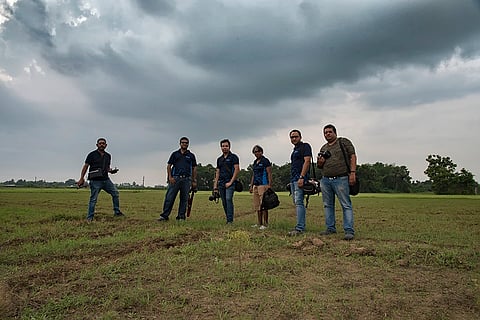
- Destinations
- Experiences
- Stay
- What's new
- Celebrating People
- Responsible Tourism
- CampaignsCampaigns
- Subscribe
- Buy Now

The Indian monsoon has stirred the imagination of poets, writers, and travellers for thousands of years, giving rise to evocative works that capture its majesty. From the rhythmic downpour to the ghostly drift of clouds and the electric theatre of lightning and thunder, the magic of the monsoon has been richly celebrated.
Poet Laureate Rabindranath Tagore, for example, dedicated many of his compositions to the monsoon. In his song "Oi Ashe Oi Oti Bhairob Horoshe," he writes:
There, there they come—monsoon clouds, thrilling and immense, heavy with moisture.
Fragrant, earth-drenched, thick with life,
Dark, brooding, magnificent—poised to burst.
For some, the Indian monsoon is more than a season—it’s a spectacle, a passion, even a pursuit. While poets and painters find inspiration in the drama of dark clouds and thunderous skies, others hit the road, chasing storms as they unravel across the landscape. These are the storm chasers: part adventurers, part scientists, and always storytellers at heart.
In Bengal, one such group calls itself the Kolkata Cloud Chasers—an informal but tightly knit community of sky-watchers who travel far and wide in search of the awe-inspiring moments that come with turbulent weather. Armed with cameras, walkie-talkies, and an unshakable enthusiasm, they have followed cloudbursts, cyclones, and monsoon phenomena from the misty heights of Sandakphu in the Eastern Himalayas to the salt-kissed shores of Henry Island on the Bay of Bengal.
The group is as eclectic as the skies they chase. Members hail from diverse professional backgrounds—freelance photographers, digital marketing professionals, IT consultants. Yet, when the skies begin to swirl, they become Roadrunner, Phoenix, Hellboi, Boltanator, Thunderman, Goodboy, Zeus, and Albatross. These are their call signs—nicknames used over walkie-talkies when mobile signals vanish during high-wind events or remote expeditions.
In May 2023, the Kolkata Cloud Chasers were on alert as Cyclone Mocha loomed over the Bay of Bengal. Though the storm made landfall in Myanmar, its spiral bands brushed Bengal’s coast on May 13, creating dramatic cloud formations. Tracking IMD data, the group set out early for Henry Island, West Bengal’s southernmost beach near the Bangladesh border. “We reached by 11 a.m. and saw dramatic skies, including a distant rain shaft,” says Chirasree.
They spent hours photographing the evolving clouds, so engrossed they skipped lunch. A month earlier, members had chased a thunderstorm near Bardhaman, a storm hotspot north of Kolkata. “When we arrived, the skies were still, but thunder cracked just as we finished lunch,” recalls Debarshi. By the Damodar River, they captured the storm’s dramatic entry. For these chasers, each journey is part science, part thrill—and a powerful way to witness and record the moods of Bengal’s weather.
Equipped with high-end gear, the Kolkata Cloud Chasers (KCC) use top-tier cameras, lenses, tripods, filters, lightning detectors, and battery packs to capture Bengal’s stormy skies. For dynamic coverage, they rely on GoPros, Insta360 cameras, DJI Pockets, and video gear for vlogs. Communication is key during storm chases, so they use mobile radios, tablets, and phones loaded with weather-tracking apps. Their custom "chase vehicles," called SCIFs (Storm and Cloud Chasing Four-Wheelers), are outfitted with recovery tools like winches, tow straps, and sand ladders for difficult terrain.
Formed in 2014, the group drew inspiration from American tornado chasers they connected with online. Back then, India’s weather updates were limited—IMD maps refreshed only every 30 minutes. Today, real-time satellite data powers minute-by-minute tracking. Still, the team relies on experience as much as tech. “Over the years, we’ve learned to trust our instincts—especially when devices fail in the middle of a storm,” they explain.
Storm chasing is still a rare and unfamiliar pursuit in India, which often makes the Kolkata Cloud Chasers a spectacle wherever they go. “Whenever we pull over with our decked-out chase vehicles, locals inevitably gather around, curious about what we’re up to,” says Chirasree. “Many think we’re just some eccentric city folks chasing storms for fun.” The confusion occasionally leads to amusing misunderstandings. In one instance, villagers mistook them for a film crew. “They thought the men in our group were villains trying to kidnap the women,” she laughs. “We had to spend quite some time explaining who we actually were!”
The group has observed noticeable shifts in weather patterns over the years. “We’ve definitely seen changes,” they say. “Take Cyclone Jawad, for example—it formed over the Bay of Bengal and tracked unusually close to the Puri coast. That trajectory was highly uncommon for that time of year.” They've also noted that kalboishakhis—Bengal’s seasonal nor’westers—and other localised storms have grown more intense. Lightning strikes, too, have increased in both frequency and lethality. “What’s interesting is that these storms now tend to bypass central and South Kolkata altogether, often taking a route through New Town instead,” they explain. According to the group, this shift is likely due to the urban heat island effect and the shrinking number of natural water bodies in and around the city—factors that influence how storms build and move.
